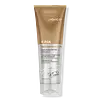What's inside
What's inside
 Key Ingredients
Key Ingredients

No key ingredients
 Benefits
Benefits

 Concerns
Concerns

 Ingredients Side-by-side
Ingredients Side-by-side

Water
Skin ConditioningSodium C14-16 Olefin Sulfonate
CleansingCocamidopropyl Betaine
CleansingSodium Methyl Cocoyl Taurate
CleansingPEG-200 Hydrogenated Glyceryl Palmate
CleansingCocamide Mipa
EmulsifyingParfum
MaskingPanthenol
Skin ConditioningCocoglucosides Hydroxypropyltrimonium Chloride
CleansingHydrolyzed Keratin
HumectantBiotin
AntiseborrhoeicSalvia Hispanica Seed Oil
MoisturisingCetrimonium Chloride
AntimicrobialHydroxypropyl Guar Hydroxypropyltrimonium Chloride
Glycerin
HumectantSodium Lauroyl Glycinate
CleansingPEG-150 Distearate
EmulsifyingPropoxytetramethyl Piperidinyl Dimethicone
Trideceth-6
EmulsifyingC11-15 Pareth-7
EmulsifyingPEG-7 Glyceryl Cocoate
EmulsifyingSodium Chloride
MaskingPolyquaternium-7
Disodium EDTA
Citric Acid
BufferingSodium Hydroxide
BufferingTetrasodium EDTA
Potassium Sorbate
PreservativeSodium Benzoate
MaskingPhenoxyethanol
PreservativeBenzyl Alcohol
PerfumingAcetic Acid
BufferingSodium Acetate
BufferingBenzyl Salicylate
PerfumingLimonene
PerfumingHexyl Cinnamal
PerfumingWater, Sodium C14-16 Olefin Sulfonate, Cocamidopropyl Betaine, Sodium Methyl Cocoyl Taurate, PEG-200 Hydrogenated Glyceryl Palmate, Cocamide Mipa, Parfum, Panthenol, Cocoglucosides Hydroxypropyltrimonium Chloride, Hydrolyzed Keratin, Biotin, Salvia Hispanica Seed Oil, Cetrimonium Chloride, Hydroxypropyl Guar Hydroxypropyltrimonium Chloride, Glycerin, Sodium Lauroyl Glycinate, PEG-150 Distearate, Propoxytetramethyl Piperidinyl Dimethicone, Trideceth-6, C11-15 Pareth-7, PEG-7 Glyceryl Cocoate, Sodium Chloride, Polyquaternium-7, Disodium EDTA, Citric Acid, Sodium Hydroxide, Tetrasodium EDTA, Potassium Sorbate, Sodium Benzoate, Phenoxyethanol, Benzyl Alcohol, Acetic Acid, Sodium Acetate, Benzyl Salicylate, Limonene, Hexyl Cinnamal
Water
Skin ConditioningStearamidopropyl Dimethylamine
EmulsifyingParaffinum Liquidum
EmollientGlycol Stearate
EmollientPEG-8 Distearate
EmulsifyingSodium Chloride
MaskingCeteth-2
EmulsifyingHydrolyzed Keratin
HumectantLaurdimonium Hydroxypropyl Hydrolyzed Keratin
Skin ConditioningMyristyl Myristate
EmollientCitric Acid
BufferingParfum
MaskingSorbic Acid
PreservativeCetyl Alcohol
EmollientStearyl Alcohol
EmollientCarthamus Tinctorius Seed Oil
MaskingYeast Extract
Skin ConditioningAloe Barbadensis Leaf Juice
Skin ConditioningKeratin Amino Acids
Skin ConditioningMethylparaben
PreservativePropylparaben
PreservativeWater, Stearamidopropyl Dimethylamine, Paraffinum Liquidum, Glycol Stearate, PEG-8 Distearate, Sodium Chloride, Ceteth-2, Hydrolyzed Keratin, Laurdimonium Hydroxypropyl Hydrolyzed Keratin, Myristyl Myristate, Citric Acid, Parfum, Sorbic Acid, Cetyl Alcohol, Stearyl Alcohol, Carthamus Tinctorius Seed Oil, Yeast Extract, Aloe Barbadensis Leaf Juice, Keratin Amino Acids, Methylparaben, Propylparaben
 Reviews
Reviews

Ingredients Explained
These ingredients are found in both products.
Ingredients higher up in an ingredient list are typically present in a larger amount.
Citric Acid is an alpha hydroxy acid (AHA) naturally found in citrus fruits like oranges, lemons, and limes.
Like other AHAs, citric acid can exfoliate skin by breaking down the bonds that hold dead skin cells together. This helps reveal smoother and brighter skin underneath.
However, this exfoliating effect only happens at high concentrations (20%) which can be hard to find in cosmetic products.
Due to this, citric acid is usually included in small amounts as a pH adjuster. This helps keep products slightly more acidic and compatible with skin's natural pH.
In skincare formulas, citric acid can:
While it can provide some skin benefits, research shows lactic acid and glycolic acid are generally more effective and less irritating exfoliants.
Most citric acid used in skincare today is made by fermenting sugars (usually from molasses). This synthetic version is identical to the natural citrus form but easier to stabilize and use in formulations.
Read more about some other popular AHA's here:
Learn more about Citric AcidHydrolyzed Keratin is derived from keratin. Keratin is a large protein that is naturally found in our hair and skin.
Studies show keratin is able to seal broken hair cuticles, helping to prevent split ends and breakage.
As a humectant, hydrolyzed keratin helps draw moisture from the air to your hair and skin. This helps keep your skin and hair hydrated.
Learn more about Hydrolyzed KeratinParfum is a catch-all term for an ingredient or more that is used to give a scent to products.
Also called "fragrance", this ingredient can be a blend of hundreds of chemicals or plant oils. This means every product with "fragrance" or "parfum" in the ingredients list is a different mixture.
For instance, Habanolide is a proprietary trade name for a specific aroma chemical. When used as a fragrance ingredient in cosmetics, most aroma chemicals fall under the broad labeling category of “FRAGRANCE” or “PARFUM” according to EU and US regulations.
The term 'parfum' or 'fragrance' is not regulated in many countries. In many cases, it is up to the brand to define this term.
For instance, many brands choose to label themselves as "fragrance-free" because they are not using synthetic fragrances. However, their products may still contain ingredients such as essential oils that are considered a fragrance by INCI standards.
One example is Calendula flower extract. Calendula is an essential oil that still imparts a scent or 'fragrance'.
Depending on the blend, the ingredients in the mixture can cause allergies and sensitivities on the skin. Some ingredients that are known EU allergens include linalool and citronellol.
Parfum can also be used to mask or cover an unpleasant scent.
The bottom line is: not all fragrances/parfum/ingredients are created equally. If you are worried about fragrances, we recommend taking a closer look at an ingredient. And of course, we always recommend speaking with a professional.
Learn more about ParfumChances are, you eat sodium chloride every day. Sodium Chloride is also known as table salt.
This ingredient has many purposes in skincare: thickener, emulsifier, and exfoliator.
You'll most likely find this ingredient in cleansers where it is used to create a gel-like texture. As an emulsifier, it also prevents ingredients from separating.
There is much debate on whether this ingredient is comedogenic. The short answer - comedogenic ratings don't tell the whole story. Learn more about comegodenic ratings here.
The concensus about this ingredient causing acne seems to be divided. Research is needed to understand if this ingredient does cause acne.
Scrubs may use salt as the primary exfoliating ingredient.
Learn more about Sodium ChlorideWater. It's the most common cosmetic ingredient of all. You'll usually see it at the top of ingredient lists, meaning that it makes up the largest part of the product.
So why is it so popular? Water most often acts as a solvent - this means that it helps dissolve other ingredients into the formulation.
You'll also recognize water as that liquid we all need to stay alive. If you see this, drink a glass of water. Stay hydrated!
Learn more about Water